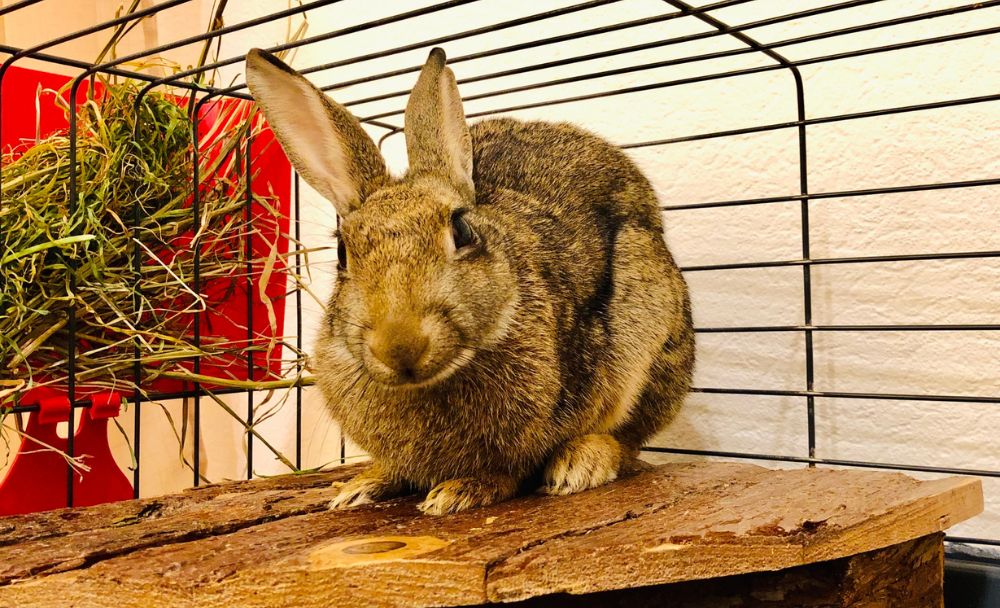If you have an indoor rabbit, you may be wondering what kind of enclosure to keep your bunny in. There are a variety of options, but a dog crate indoor rabbit hutch is a cost-effective, creative option.
Dog crates make an excellent choice for a rabbit cage DIY project. They offer space for large breed rabbits, are cheaper than actual rabbit cages, and allow you the option to design exactly what you want for your bunny’s enclosure.
We are going to cover all the benefits of using a dog crate to create an indoor rabbit hutch. We are also going to cover the DIY topics that you need to consider when making your bunny’s new home.
Can a rabbit live in a dog crate?
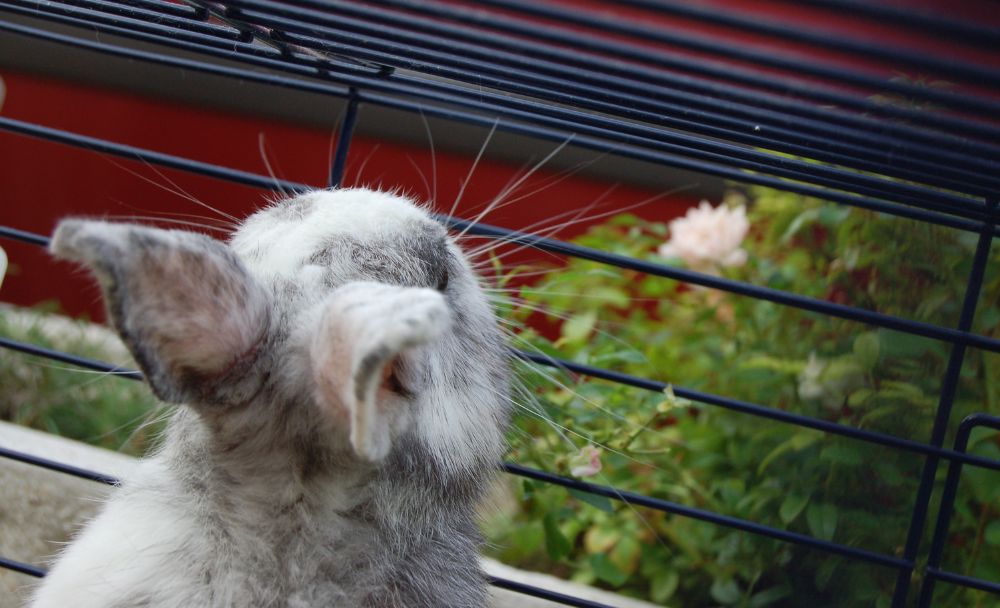
Dog crates make an awesome indoor rabbit hutch. Combining it with a playpen-like area will allow your bunny the room and freedom to run around with a nice, cozy den to return to when he’s done playing.
Adjustments can be made to the base of the crate that will prevent your bunny from throwing his hay and poop out onto the floor. Additionally, you have the option to litter pan train him. This will make clean-up of his cage so much easier.
Buying a dog crate
When buying a dog crate for an indoor rabbit hutch, you will want to buy a crate meant for a larger dog species. According to MoRabbit, crates that are 48 or 54 inches are ideal. If you can find a crate with a two-door option, this is even better as it allows better access for cleaning.
Benefits of using a dog crate for a rabbit
A dog crate indoor rabbit hutch allows you to raise your rabbit inside as part of the family. This keeps your bunny safe from hazards like weather extremes and predators.
Additionally, a dog crate offers a more cost-effective option than pet store cages geared toward rabbits. Because it starts out as a bare bones crate, you can customize it exactly how you want it to be for your bunny. With all the upward space, you have the option to install a shelf or even two for more floor space.
Most dog crates fold flat for storage or travel. This means if you are going somewhere and taking your bunny along, his enclosure will be able to go too.
Because of the size of dog crates, especially those for large breed dogs, they are suitable for larger breed rabbits. Your bunny will be comfortable in his DIY indoor rabbit hutch.
DIY Tips for creating a dog crate indoor rabbit hutch
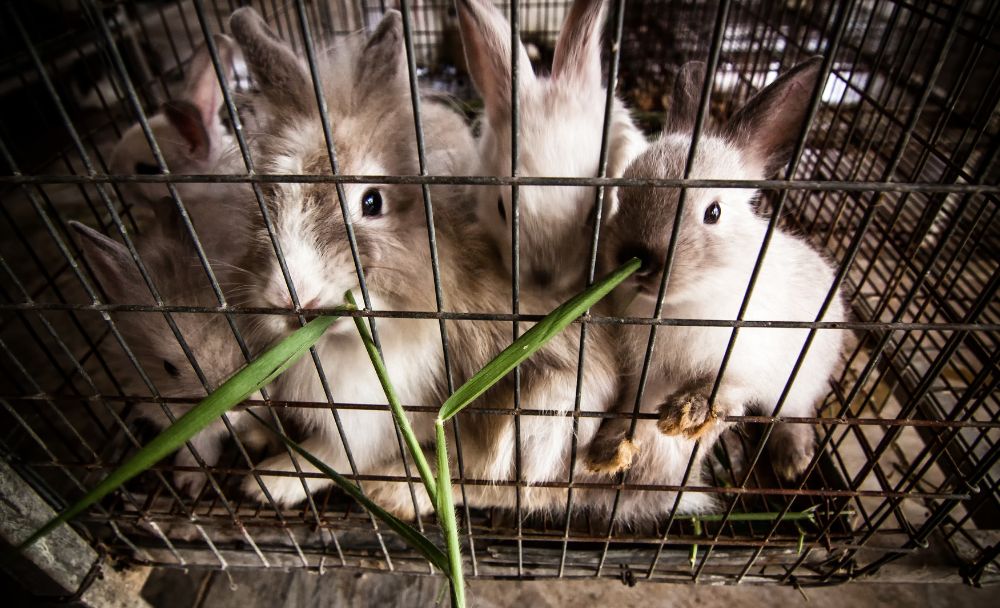
To make a fantastic indoor rabbit hutch from a dog crate, we have many rabbit cage DIY recommendations.
Planning
When deciding to transform a dog crate into an indoor rabbit hutch, you will need to plan on what you want to accomplish. You are going to need several things to keep your bunny happy. First, you need to obtain a crate that is large enough for your bunny to make three hops in one direction and be able to stand on his hind legs to look around.
You will need to decide what kind of floor you want to have or if you are going to litter train your bunny. A dog crate will not be like a traditional hutch where his droppings will fall to the ground for easy cleanup.
Your bunny will need a den, a water bowl, and a food bowl so you will need to plan on where these will be located within the crate.
Size
The dog crate will need to be a large dog-sized crate. You will need as much space as possible for your bunny since he will spend a lot of time in his indoor hutch.
Additionally, these larger crates allow for the addition of shelves and ramps, which give your bunny more space to move around the cage.
New Vs Used Dog Crate
If you have an old dog crate, there is nothing wrong with repurposing it to make an indoor rabbit hutch. If everything is still in working order and you can sufficiently clean it and sterilize it, it will be just as good as a new dog crate.
Buying new also has its benefits. You can measure the space where you are going to place your bunny’s new home and choose a crate that matches that size.
Disinfect Before Use
You will want to disinfect your crate before use, especially if it is repurposed. In order to make the cage safe for your bunny, you will need to make sure all bacteria, dirt, and any other residues are removed before he moves in.
Clean it thoroughly with soap and water. Then you will want to use a disinfectant that is safe for use with animals. You can consult your local pet shop for a suitable product. Allow the cage to dry before placing your rabbit or anything in it. This will ensure the habitat is safe for your bunny.
Consider The Bar Spacing
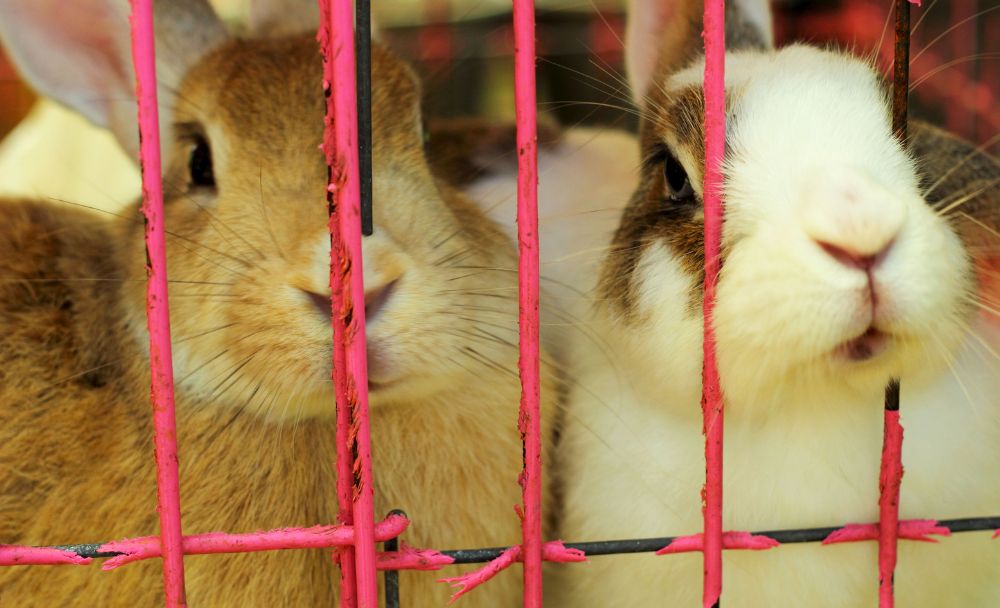
Dog crates are not created equally when it comes to bar spacing. You will need to consider the spacing of your crate before you put your bunny inside his new home. If the bars are too far apart, he may be able to get his head or even his entire body if he’s a baby between the bars.
Don’t worry, there is a way to solve this problem. You can cover the bars of the enclosure with wire mesh. If this solution is to keep baby rabbits inside, then you can remove the mesh when they get bigger.
When installing the mesh, ensure that there are no sharp edges that your bunny can hurt themselves on.
Consider also if there’s any coating on the bars, like in the image above. Remember, rabbits love to chew! We don’t want them chewing off any plastic coating that could harm them if swallowed.
Door Position
Dog crates come with a variety of door options. They can be on the short side, the long side, or on two sides. Based on where you are placing your enclosure, you will have to decide which door setup works best for you.
Having two doors or the door on the longer side will allow you to have better access to cleaning the indoor rabbit hutch. Regardless of which door type you choose, you will need to have quick access to your rabbit.
Choose The Flooring Materials
If you have a potty-trained bunny, you can elect to have a nice floor covering in your crate. Cage liners and rugs are an option for making the crate into a comfortable home.
If your bunny is not potty trained or you are in the process of potty training, you will need to choose a different option for the flooring. Most dog crates come with either a metal or plastic tray or pan on the bottom.
You can leave the flooring like this and just clean it daily or you can add a layer of wire mesh above the pan. The wire mesh will allow the droppings to fall to the pan beneath for easier cleaning. However, the wire can cause foot discomfort.
Add Depth To The Floor
The depth of the floor of most dog crates is very shallow. This means that your bunny will most likely throw his droppings and hay out of the bars of his indoor rabbit hutch, making a mess in your house.
One way to solve this problem is the create a barrier around the bottom of the hutch using wooden skirting or corrugated plastic.
Adding a deep tray with litter and another with bedding is another solution to keeping your bunny’s mess to a minimum.
Create A Shelf Or Two
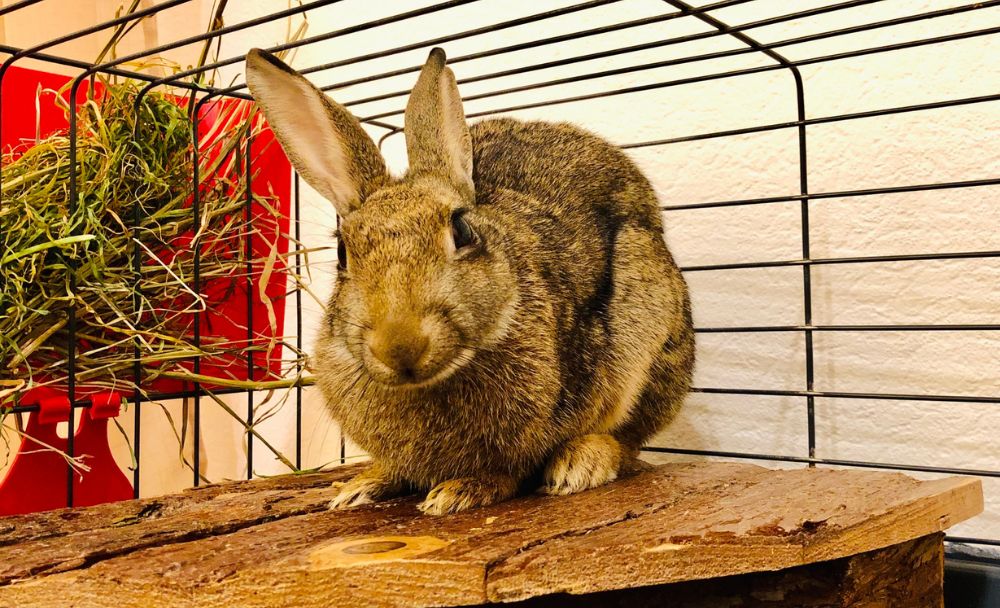
Adding a shelf to the enclosure will give your bunny more surface area to interact with. If the dog crate is large enough, you may even be able to add two or three shelves. You’ll want to make sure that the wood is not treated with anything that is toxic to rabbits as we all know they enjoy chewing on anything they can get their teeth on.
Build A Ramp
For every shelf you build in the hutch, you will need a ramp for your bunny to access it. The top edges of each ramp will need to be cut at angles to meet snugly with the shelves. There should be no gaps and no pieces sticking up as these could be dangerous to your bunny.
Encourage Your Rabbit To Go Upstairs
You may need to encourage your bunny to go upstairs. If you find that he is isolating himself to one level, try placing treats on each level to entice him up the ramps. After some time, he will most likely become used to his new home and easily go up and down the ramps.
Add A Hidey Hole
Inside the dog crate you will have to add something that will function as a hidey hole or den for your bunny. This is crucial to his happiness. It will provide him with a safe place and a sense of security. Without this, he may develop anxious behaviors like biting and excessive chewing.
Add A Bathroom
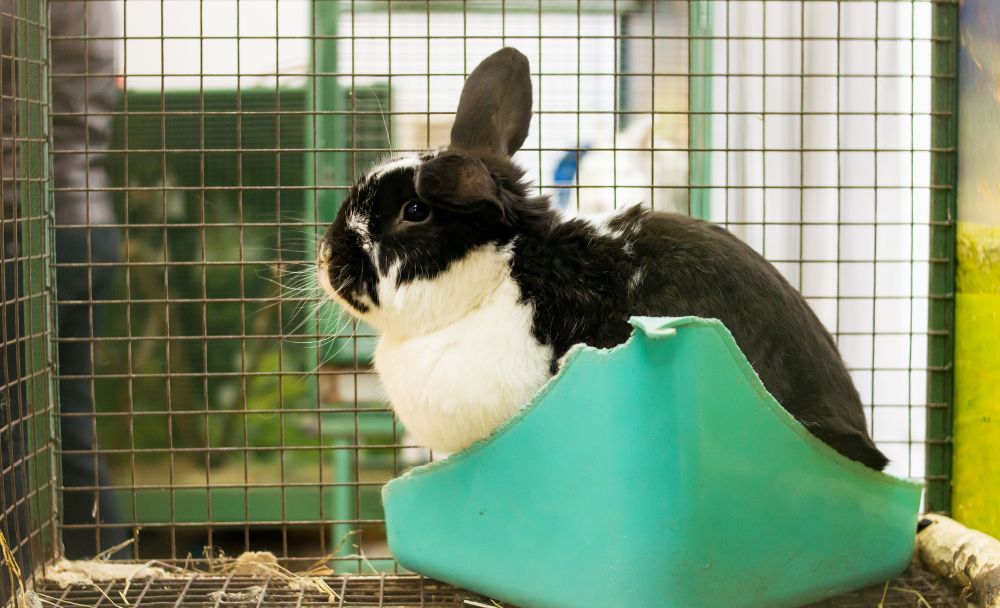
Litter training a bunny is a very easy task as they take to it quite well. If you place a litter pan in your bunny’s indoor hutch, he will quickly learn how to use it and make cleaning his enclosure a lot easier. Plus, when he is out and about in your home, he will be less likely to make messes.
Provide Fresh Water And A Hay Station
You will need to provide your bunny with a source for fresh water. If you find that he is fouling his water bowl up quickly, visit your local pet shop to pick up a water dispenser that has a closed reservoir and a dispenser tube.
A hay rack will need to be added to the outside of the enclosure. Adding hay directly to the floor of the bunny’s home may not be the best choice as he may destroy it by urinating on it. The hay rack will allow him to pull the hay in as he wants it, keeping it clean and fresh.
Don’t Forget To Add Toys
Bunnies also need intellectual stimulation just like your dog and cat. Make sure you provide yours with toys to keep him occupied and give him something to chew on to maintain his teeth.
Your Bunny Can Enjoy Their New Dog Crate Converted Hutch!
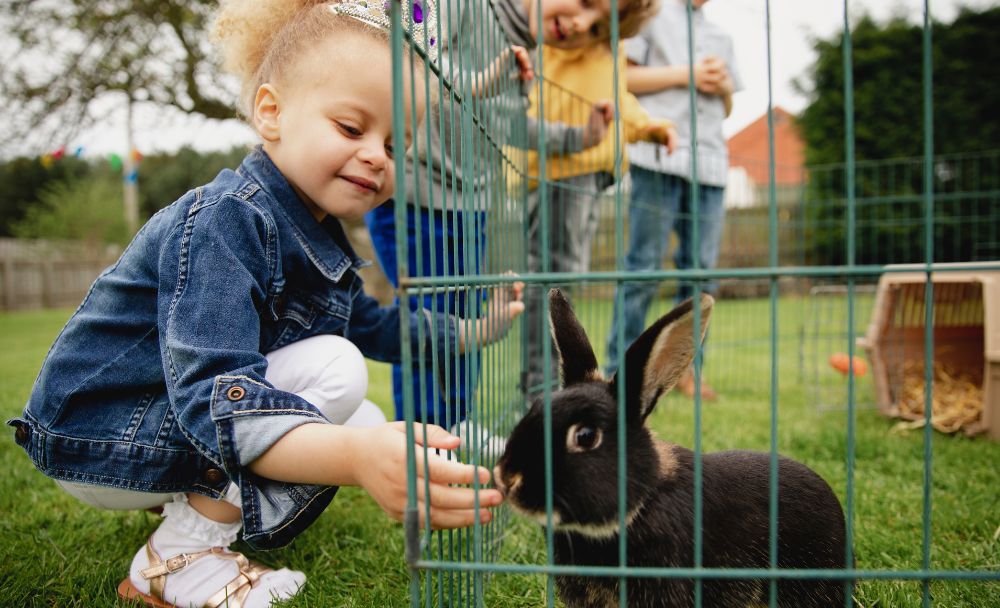
A dog crate offers an excellent option for housing your bunny. You are given the creative license to make an indoor rabbit hutch that is exactly what you want at a more affordable price than pet shop rabbit cages.
Whether you use an old or new dog crate, you can create an exception enclosure for your bunny. Make sure you add a bathroom, food, water, a den, shelves, and ramps and your bunny will be extremely happy in his new home.

